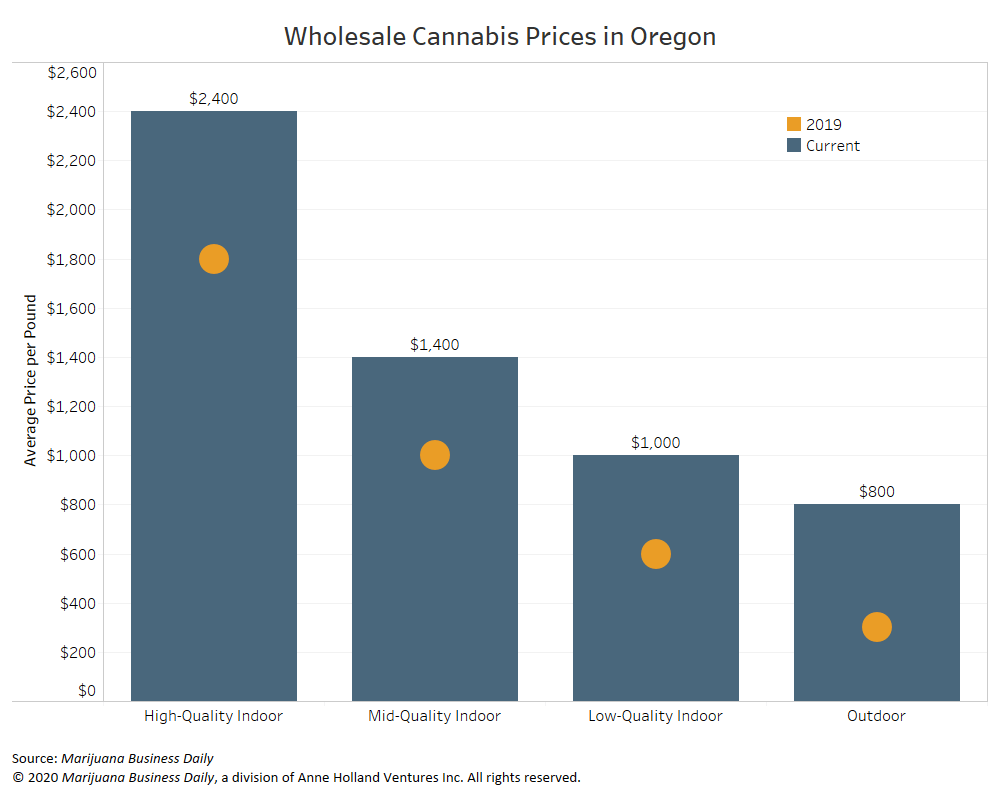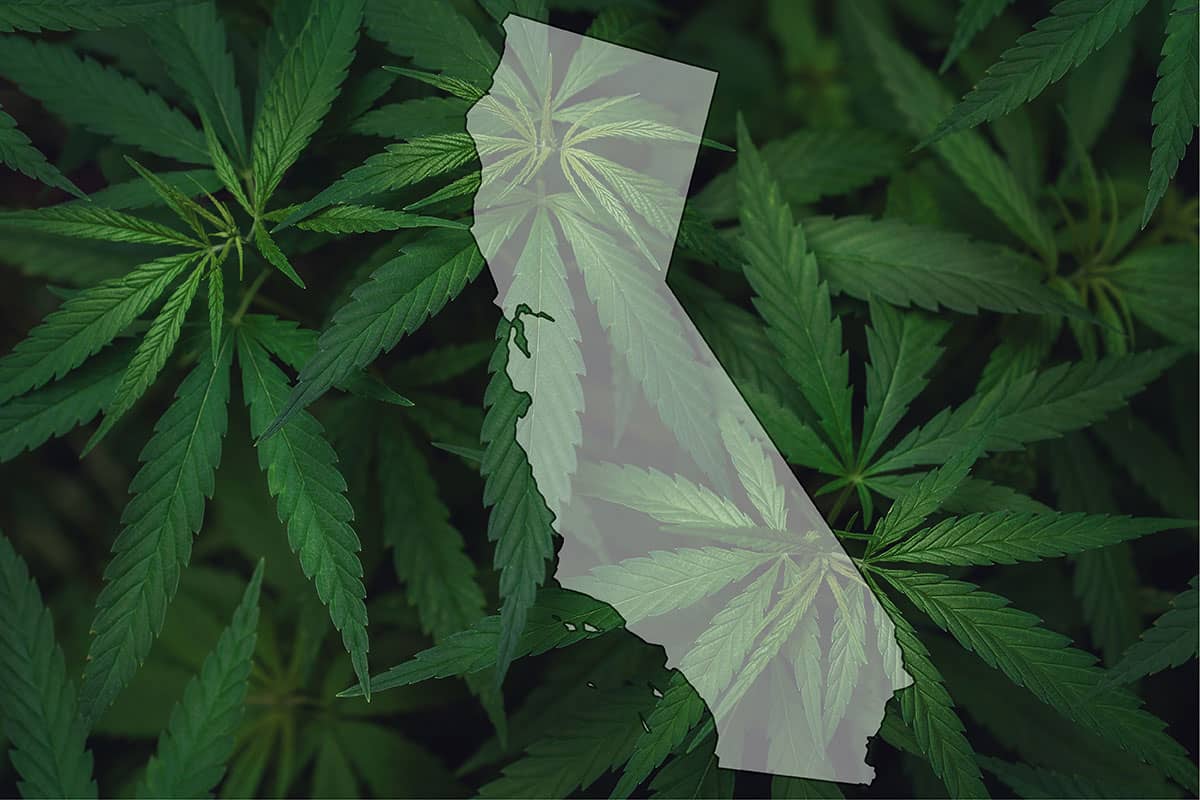(This is the fourth in a series of stories from Marijuana Business Daily examining wholesale prices in U.S. recreational marijuana markets. Part 1 covered Nevada, Part 2 Washington state and Part 3 Oregon.)
California cannabis growers report a favorable wholesale market with increasing demand despite a lack of retail outlets and continued opposition to legal recreational marijuana from the majority of municipalities and counties in the state.
The positive upward trend of both prices and demand has some businesses maxing out capacity and increasing production.
Growers in the state report pounds of wholesale cannabis flower are selling for:
- Indoor: $1,800-$2,200 (similar to this time last year)
- Greenhouse: $1,150-$1,300 (up 30% from last year)
- Outdoor: $900-$1,100 (similar to this time last year)
Shelton said prices started going up last summer, owing to fewer competitors as many of the cultivators who had temporary licenses before 2018 either failed to acquire annual permits or went out of business.
However, growers do report some significant challenges persist, including:
- More retail outlets are needed to create an adequate marketplace.
- The majority of municipalities across the state haven’t got on board with licensing cannabis businesses.
- Taxes are too high. Flower is taxed at about $150 regardless of the price it fetches on the market, which cuts into profits.
- The illicit market continues to thrive, both in the cultivation and retail sectors.
In midwinter, wholesale flower prices typically fall to the lowest point in the year as outdoor growers flood the supply, and prices usually remain depressed well into the spring.
But several growers reported that prices are already rebounding as demand grows and the outdoor harvest hasn’t impacted supply as strongly as expected.
‘Over the hump’
The dearth of local approval of cannabis licenses has limited the number of retail stores throughout the state.
One grower, Graham Farrar, president of Glass House Group, a vertically integrated cannabis company in Santa Barbara County, said that although there aren’t nearly as many retail outlets – only 618 – as there should be in the state, “it’s getting better.”
“There are more licensed stores open today than there ever have been, and there will be more by the end of 2020 than there are today,” he added.
“For those who are persevering, it’s a great place to be in.”
Farrar said his company just brought its second farm online and now has about 500,000 square feet of operational greenhouse, indoor and extraction space.
He isn’t worried about the market becoming oversupplied in the near future because nearly 70% of the counties in the state don’t allow for legal cannabis businesses.
“There are less cultivation licenses today than there were in 2018,” Farrar said. “With more stores and more consumers.”
Glass House plans to open another dispensary soon in the Southern California region.
“We’re over the hump,” Farrar said. “It was hard. It took a lot of work. And it was very expensive … but the market is good.”
Looking north
Up in the Emerald Triangle, grower Tobias Hafenecker-Dodge, who owns Humboldt Growers Network in Garberville, expects prices to start going up dramatically.
“It looks like there’s about to be a run on the NorCal market,” he said.
According to Hafenecker-Dodge, buyers from all over the state are looking toward the Emerald Triangle for product, which means that reserves are running low in other areas.
Shelton backed that up, saying the outdoor harvest seems to be weaker than expected.
“We’ve seen a huge uptick in demand, and prices already starting to go back up again,” she added. “That’s unusual.”
Six distributors recently contacted Hafenecker-Dodge for bulk flower amounting to roughly 3,500 pounds.
He expects to see prices move up to around $1,200 a pound for wholesale outdoor flower – maybe even reaching up to $1,600 a pound by the summer.
Most of the buyers are looking for higher potency strains that hit the 23% THC mark or higher.
One reason product is scarce, according to Hafenecker-Dodge: A lot of cultivators in his region have gone out of business because there aren’t enough outlets to sell into, and prices on the wholesale market were too low.
Middleman issues
Another grower in the region, Dylan Mattole with Mattole Valley Organics in Humboldt County, agreed that the lack of retail was a “limitation.”
“We’d have a much stronger market if we had more retail,” he said.
To help alleviate this, Mattole would like to see more direct sales with end users. The distribution model in the state makes it difficult for cultivators to build relationships with individual stores.
“Our product goes through one to three brokers before it gets to the retailer,” he added.
Another change Mattole would like to see: Allowing growers to have trade samples so cultivators can find new buyers and build relationships with retailers.
Autumn Brands’ Shelton wonders how distributors are making money in the market, considering how tight margins are with the added taxes.
She expects that the companies that will be able to survive long term will be vertically integrated.
“It’s going to be very challenging for anyone who doesn’t have their own cultivation or dispensary,” Shelton added.
Shelton also would like to see the tax burden lessened.
“Until they can pull that back a little bit so that people can afford to be in this regulated market,” she added, “you’re going to see a lot of people who just can’t make it.”
Bart Schaneman can be reached at barts@mjbizdaily.com






